In the intricate tapestry of our daily lives, safety often weaves itself into the background, quietly shaping our environments and influencing our behaviors. Yet, when accidents occur, the threads of safety regulations come to the forefront, revealing their significant role in personal injury cases. These regulations, designed to protect individuals from harm, set the standard for behavior and responsibility in both public and private spheres. As we delve into the intersection of law and personal safety, we’ll explore how these regulations not only govern actions but also influence the outcomes of personal injury claims. By understanding their importance, we can better appreciate how they serve as both a shield against negligence and a beacon of accountability in our quest for justice.
Understanding Safety Regulations as Legal Fundamentals in Personal Injury Law
In personal injury law, safety regulations serve as critical pillars that underpin legal arguments and liability determinations. These regulations, established by governmental bodies, define the minimum standards of safety within various industries and settings. When these standards are violated, they can create a strong basis for claims, leading to successful personal injury cases. Understanding how these regulations operate is essential for both victims and legal practitioners alike.
Safety regulations can be categorized into several key domains:
- Occupational Safety: These regulations are set forth by agencies such as OSHA (Occupational Safety and Health Administration) to ensure work environments are safe for employees.
- Consumer Product Safety: Guided by entities like the CPSC (Consumer Product Safety Commission), these regulations aim to protect consumers from hazardous products.
- Public Health Standards: Local and state authorities enforce these regulations to safeguard communities against health hazards that can lead to injury.
The legal significance of these regulations is underscored when determining negligence. A breach of safety regulation can be interpreted as negligence per se, which automatically establishes liability if it can be demonstrated that the violation directly caused harm. In practical terms, this means that victims may not need to prove negligence explicitly; rather, they can rely on the failure to adhere to established safety standards as evidence of wrongful conduct. Moreover, the presence of safety regulations encourages a culture of accountability, compelling businesses and organizations to prioritize the well-being of their employees and customers.
| Type of Regulation | Leading Agency | Examples of Violations |
|---|---|---|
| Occupational Safety | OSHA | Lack of PPE, unsafe machinery |
| Consumer Product Safety | CPSC | Defective toys, hazardous chemicals |
| Public Health Standards | Local Health Departments | Filthy restaurants, unsanitary conditions |
Therefore, legal professionals must be adept not only in the nuances of personal injury law but also in the complexities of the applicable safety regulations. Staying updated on these regulations and their implications can significantly impact the outcome of cases, ensuring that victims receive the justice and compensation they deserve. The relationship between safety regulations and personal injury law exemplifies how legal frameworks shape societal expectations concerning safety and accountability.

Evaluating the Impact of Compliance with Safety Standards on Injury Outcomes
When organizations adhere to established safety standards, the ripple effects can significantly influence personal injury outcomes. Compliance with these regulations not only fosters a safer environment but also profoundly impacts the legal landscape when incidents occur. By examining the correlation between safety compliance and injury outcomes, we can better understand how regulations serve both preventative and remedial functions.
Key Outcomes of Compliance:
- Reduction in Accidents: Ensuring strict adherence to safety protocols reduces the likelihood of accidents, which, in turn, minimizes injury rates.
- Legal Defense: Organizations that comply with safety standards may have stronger legal defenses in personal injury lawsuits, demonstrating that they took necessary measures to protect individuals.
- Insurance Implications: Decreased incidents can lead to lower insurance premiums, as insurers view compliant organizations as lower-risk entities.
In evaluating the effectiveness of compliance, a table illustrating injury outcomes in two hypothetical companies—one following safety standards and one neglecting them—provides clearer insight:
| Company | Injuries Reported | Legal Claims Filed | Insurance Costs |
|---|---|---|---|
| Company A (Compliant) | 5 | 2 | $10,000 |
| Company B (Non-Compliant) | 20 | 10 | $50,000 |
This juxtaposition emphasizes that compliance not only serves a protective function but can also lead to substantial financial benefits for organizations. Ultimately, as more companies prioritize safety regulations, the overall reduction in injuries can reshape the landscape of personal injury litigation, fostering accountability and encouraging continuous improvement in workplace safety.

Navigating Liability: How Violations of Safety Regulations Shape Case Resolutions
In the realm of personal injury cases, the presence of safety regulations serves as both a guideline and a legal benchmark. When a violation occurs, it can significantly influence the trajectory of a case, often dictating not just the responsibilities of the involved parties, but also shaping the outcomes of litigation. Understanding how these regulations interact with claims is vital for both plaintiffs and defendants.
Safety regulations exist to protect individuals from harm, establishing standards for various industries. When these standards are breached, the implications can extend beyond the immediate injury to encompass broader accountability. Key factors include:
- Negligence Per Se: Violating a statute often equates to negligence, placing the duty of care in clear focus.
- Burden of Proof: The burden may shift to the defendant to prove compliance with safety standards.
- Compensation Adjustments: Severity of violations can lead to higher penalties or settlements to compensate injured parties.
To illustrate how safety violations impact case resolutions, consider the following table that outlines potential outcomes based on the degree of violation:
| Degree of Violation | Potential Legal Outcome | Compensation Range |
|---|---|---|
| Minor Violation | Reduced Liability | $1,000 – $5,000 |
| Substantial Violation | Shared Liability | $5,000 - $20,000 |
| Severe Violation | Full Liability | $20,000+ |
Interpreting safety regulations not only aids in understanding culpability but also imbues the court’s decisions with an additional layer of moral responsibility. Judges and juries often take these violations into account, recognizing the societal implications of neglecting safety standards. As such, regulators and legal entities alike must work collaboratively to uphold these principles and ensure justice prevails in personal injury disputes.

Practical Strategies for Utilizing Safety Regulations in Injury Claims and Defense
In the intricate landscape of personal injury cases, safety regulations can serve as powerful tools for both claimants and defendants. Understanding how to leverage these regulations not only informs legal strategies but also enhances the overall efficiency of the legal process. Here are some practical approaches to utilize safety regulations effectively:
- Identify Relevant Regulations: Begin by thoroughly researching safety regulations that apply to the specific context of the injury. This can include industry standards, local codes, and federal laws that may have a direct bearing on the case.
- Establish Negligence: Use the identified regulations to construct a case for negligence. Demonstrating that a breach of safety regulation directly contributed to the injury can create a strong basis for liability.
- Engage Expert Witnesses: Incorporate testimonies from safety experts who can attest to the importance of compliance with safety protocols. Their expertise can substantiate claims or defenses regarding industry practices.
- Gather Documentation: Compile all relevant documentation, such as inspection reports, safety audits, and compliance records, to support your position. This evidence can be pivotal in substantiating claims or countering defenses.
For defendants, understanding the nuances of safety regulations provides an opportunity to challenge the basis of the plaintiff’s claims. Strategies could include:
- Prove Compliance: Demonstrating adherence to safety regulations can serve as a defense against allegations of negligence. Evidence of compliance can help diminish liability.
- Highlight Contributory Factors: Focus on other variables that may have led to the injury, such as the claimant’s own actions, which could mitigate the defendant’s responsibility.
- Legal Precedents: Research previous cases that have invoked similar regulations. Presenting case law where plaintiffs failed to meet the burden of proving negligence can strengthen your defense.
Below is a simplified comparison table illustrating key aspects of utilizing safety regulations in injury claims:
| Aspect | Plaintiff’s Perspective | Defendant’s Perspective |
|---|---|---|
| Compliance | Demonstrates lack of adherence | Proves full compliance |
| Expert Testimony | Supports claims of negligence | Challenges breach claims |
| Document Evidence | Strengthens case | Refutes liability |
In sum, navigating safety regulations requires a strategic approach that encompasses a detailed understanding of applicable laws, expert insight, and diligent documentation. Using these regulations wisely can profoundly influence the outcome of personal injury claims, ensuring that both sides are equipped to present their case effectively.
Closing Remarks
the intricate web of safety regulations serves not only as a framework for protecting individuals but also as a critical determinant in personal injury cases. These regulations, borne from the collective effort to mitigate risks and enhance public welfare, shape the landscape of legal accountability. As we navigate the complex terrain of injuries and liability, understanding the role of these regulations becomes essential. They not only guide the actions of organizations and individuals alike but also provide a critical lens through which to evaluate claims and seek justice. As we move forward, the ongoing evolution of safety standards will undoubtedly continue to influence both preventative measures and the resolution of disputes in the legal realm, reinforcing the importance of vigilance and adherence to the rules designed to keep us all safe. Whether you’re a policymaker, a legal professional, or simply someone interested in the dynamics of personal safety, recognizing the significance of these regulations can empower us all to foster a safer society.


